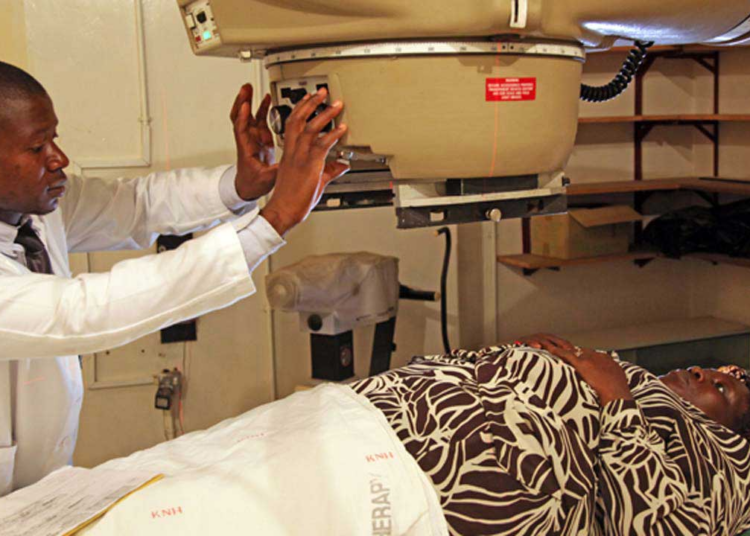Breast cancer treatment costs N20m Dearth of specialists, late diagnosis limit chances of survival
Nigeria has one radiation oncologist to 2,000 patients 24 Nigerian women die daily from cervical cancer
Nigeria has one radiation oncologist to 2,000 patients 24 Nigerian women die daily from cervical cancer
As Nigeria joins the rest of the world to mark World Cancer Day, challenges in cancer care continue to cast a shadow over the survival chances of thousands of patients, LEADERSHIP checks revealed.
The country faces a severe shortage of specialists, a high cost of treatment, and late-stage presentation of cases, factors that have made cancer one of the deadliest diseases in Nigeria.
Nigeria is critically short of oncologists, particularly radiation oncologists, who play a key role in cancer treatment. The Nigerian Cancer Society (NCS) president, Prof. Abidemi Omonisi, described the situation as dire.
“Ideally, one radiation oncologist should manage between 250 to 500 cancer patients. But in Nigeria, the ratio is approximately 1:1,800, meaning one radiation oncologist is responsible for nearly 2,000 cancer patients,” he said.
Currently, Nigeria has less than 80 oncologists serving a population of over 200 million. The situation is further worsened by the ongoing “Japa” syndrome, which involves the mass migration of healthcare professionals to countries with better working conditions.
Besides the shortage of specialists, there is also a lack of cancer treatment equipment. “At a time, we had no functional radiotherapy machine in the country, and patients had to travel to Ghana and other countries for treatment,” Omonisi recalled.
While the situation has improved slightly, it is still far from adequate. The federal government recently approved the establishment of six additional cancer treatment centres, but experts warn that without enough specialists, the machines alone will not solve the problem.
Cancer treatment is prohibitively expensive. Prof. Omonisi estimates that stabilising a breast cancer patient, covering diagnosis, hospital admission, and preliminary tests costs around N20 million.
One significant financial challenge is the cost of specialised tests like immunohistochemistry, which helps determine the type of breast cancer a patient has and the most effective treatment. Due to cost constraints, many hospitals do not perform this crucial test, forcing patients to rely on generalised treatment, which may not be practical, he said.
A tragic example is Eunice Obiora, who was diagnosed with stage 1 cancer but lost her life due to the overwhelming cost of treatment, among other challenges.
To address the financial burden, the NCS has called for an increase in the Cancer Health Fund (CHF) allocation in the 2025 national budget from N150 million to at least N1 billion. Omonisi insists that Nigeria must prioritise cancer funding to reduce mortality rates.
“No country can effectively manage cancer without a dedicated fund. We need at least N1 billion annually to support cancer patients,” he stressed.
National coordinator of the National Cancer Control and Nuclear Medicine Programme at the Federal Ministry of Health and Social Welfare, Dr Uchechukwu Nwokwu, explained that cancer treatment involves surgery, chemotherapy, and radiotherapy, but that while most federal hospitals offer surgery and chemotherapy, only 12 hospitals currently provide radiotherapy services.
The government has committed to establishing additional radiotherapy centres to reduce the burden on existing facilities and curb medical tourism. However, stakeholders insist that while expanding facilities is crucial, addressing the shortage of skilled personnel remains a priority.
Dr Nwokwu acknowledged the sector’s manpower shortage but gave assurance that the federal government was working to bridge the gaps.
“So we are really talking about increasing training to have adequate manpower. Unfortunately, the ones who are trained are all leading to psychopath syndrome, which I think the ministry is taking steps to address,” he said.
He told LEADERSHIP that the Federal Ministry of Health had mandated a multidisciplinary approach to cancer treatment, ensuring that various specialists, including pathologists, dermatologists, physiotherapists, and oncology nurses, work together to manage cancer cases.
Dr Nwokwu further said that, in collaboration with the World Health Organisation (WHO), the Federal Ministry of Health has developed awareness materials on childhood cancer. These materials will be translated into multiple languages and aired nationwide, starting on International Childhood Cancer Day (February 15).
According to him, the same treatment modalities used for adults – surgery, chemotherapy, and radiotherapy – are also used for children. However, the absence of dedicated pediatric oncology centres remains a challenge.
“The government is now paying attention to childhood cancer, and discussions are ongoing to improve diagnosis, treatment, and funding,” he stated.
World Cancer Day is commemorated on February 4 every year. This year’s theme is ‘United by Unique’, which emphasises a people-centred approach to cancer care, by prioritising individuals and communities within cancer care and health systems.
Cancer is a group of diseases involving the abnormal multiplication and spread of cells due to genetic mutations. It can affect almost any part of the body and disrupt normal functions.
According to studies, symptoms of cancer vary but may include fatigue, night sweats, unexplained weight loss, skin changes, persistent pain, or organ-specific symptoms like blood in stool or new lumps.
The risk factors include a family history of cancer, lifestyle choices (smoking, poor nutrition, and lack of exercise), environmental exposures (toxins like asbestos and pesticides), radiation (UV radiation or excessive medical radiation) and hormonal therapy.
According to the International Agency for Research on Cancer (IARC), about one in five people develop cancer in their lifetime. Approximately one in nine men and one in 12 women die from the disease.
The IARC identified three major cancer types globally in 2022: lung, breast and colorectal cancers.
Lung cancer was the most commonly occurring cancer worldwide, with 2.5 million new cases accounting for 12.4 per cent of the total new cases. Female breast cancer ranked second (2.3 million cases, 11.6 per cent), followed by colorectal cancer (1.9 million cases, 9.6 per cent), prostate cancer (1.5 million cases, 7.3 per cent) and stomach cancer (970,000 cases, 4.9 per cent).
In Nigeria, the WHO reports that cancer kills 240 Nigerians daily, meaning 10 Nigerians die every hour from cancer. The global health body revealed that cervical cancer kills about 24 Nigerian women daily, prostate cancer kills about 26 Nigerian men daily, and breast cancer kills about 40 Nigerians daily.
Meanwhile, in recognition of the need for a more coordinated and multi-sectoral response to the growing cancer burden in the country, the federal government established the National Institute for Cancer Research and Treatment (NICRAT) to provide national leadership in cancer research, treatment and control in Nigeria.
The NICRAT Establishment Act 2017 also empowers the Institute to guide scientific improvement in cancer prevention, treatment, and care and to coordinate and liaise with a wide range of groups and healthcare providers interested in cancer.
Acting director of Cancer Prevention and Control at NICRAT, Dr Usman Waziri, revealed that between September and December 2024, over 330 patients benefited from the CHF, an improvement compared to previous years.
“We decentralised the approval process to ensure faster turnaround times and, so far, N256 million has been disbursed to assist patients,” he said.
Despite this progress, Dr Waziri emphasised that the fund’s limited budget means many more patients cannot access financial support. NICRAT is advocating the complete transfer of the CHF budget to its control, enabling it to support up to 2,000 patients by the end of 2025.
For now, thousands of cancer patients in the country continue to battle not just the disease but also the harsh realities of an underfunded and overstretched healthcare system.




